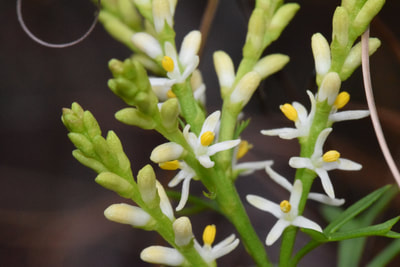| One of the bonuses of moving to Australia is that I now get to see native Proteaceae everywhere I go! Proteaceae is a large family of flowering plants (of 81 genera and about 1700 species) mostly distributed in the Southern Hemisphere, especially in Australia and South Africa (map here). Proteaceae are the main reason why I came to spend a year here in Australia 11 years ago to work as a postdoc with Peter Weston, the world's leading expert on this family. On a recent bushwalk (= hike in Australian English) in the spectacular Blue Mountains earlier this month, I was lucky to come across the plant pictured on the left. Meet Symphionema montanum, a rare species of Proteaceae endemic to New South Wales found only in the central mountain ranges from 400 to 1200 m in altitude (see this map from the Australasian Virtual Herbarium). Even though it looks very different from the more common genera of Proteaceae around here such as Banksia, Grevillea, or Isopogon, this small shrub is immediately recognized as a member of the family. The peculiar, divided (pinnatisect) leaves are indeed characteristic, as are the flowers with just four tepals (no distinction between sepals or petals), four stamens opposite the tepals, and a single carpel with superior ovary. |
This of course does not imply that Symphionema looks like the ancestor of Proteaceae! For instance, the combination of spread out tepals and yellow, upright anthers (the part of stamens containing the pollen) is suggestive of buzz pollination by bees (as we suspect for the flowers of Sirdavidia solannona we discovered in Gabon three years ago). This has not been proved yet, but if true, this highly specialized pollination mode probably evolved rather recently and is likely not ancestral in this family.
For more information, see:



 RSS Feed
RSS Feed
